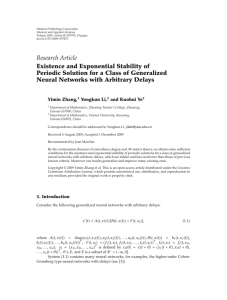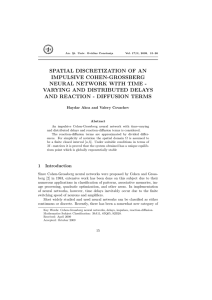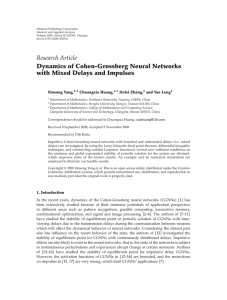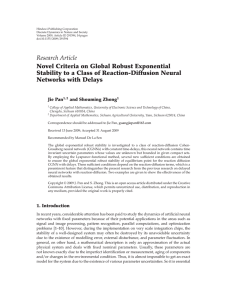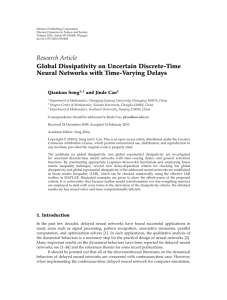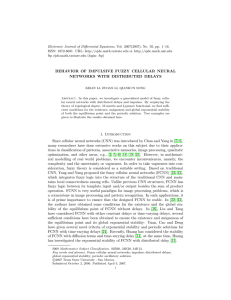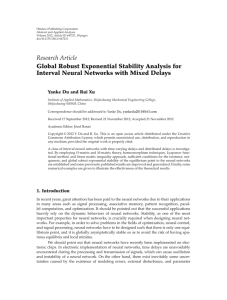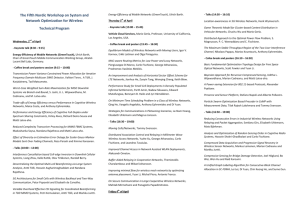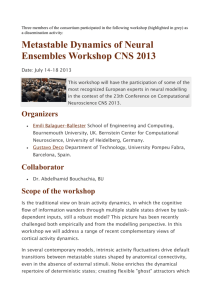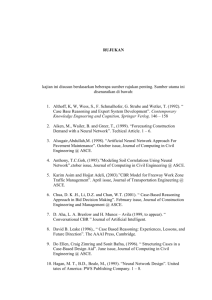Electronic Journal of Differential Equations, Vol. 2007(2007), No. 89, pp.... ISSN: 1072-6691. URL: or
advertisement
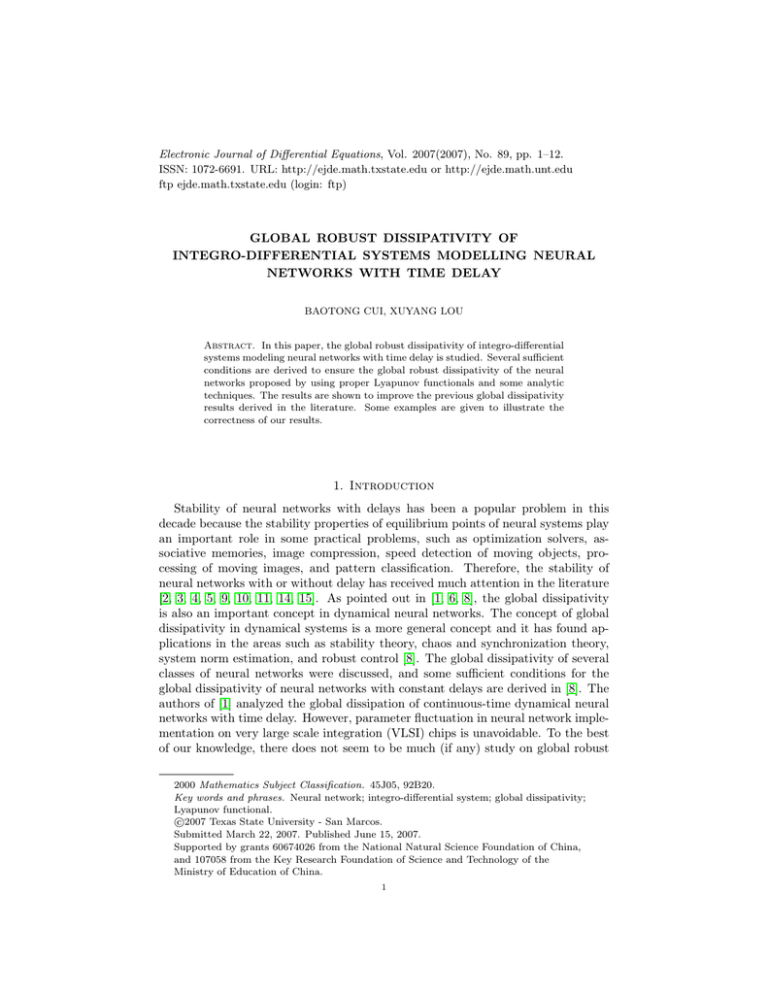
Electronic Journal of Differential Equations, Vol. 2007(2007), No. 89, pp. 1–12.
ISSN: 1072-6691. URL: http://ejde.math.txstate.edu or http://ejde.math.unt.edu
ftp ejde.math.txstate.edu (login: ftp)
GLOBAL ROBUST DISSIPATIVITY OF
INTEGRO-DIFFERENTIAL SYSTEMS MODELLING NEURAL
NETWORKS WITH TIME DELAY
BAOTONG CUI, XUYANG LOU
Abstract. In this paper, the global robust dissipativity of integro-differential
systems modeling neural networks with time delay is studied. Several sufficient
conditions are derived to ensure the global robust dissipativity of the neural
networks proposed by using proper Lyapunov functionals and some analytic
techniques. The results are shown to improve the previous global dissipativity
results derived in the literature. Some examples are given to illustrate the
correctness of our results.
1. Introduction
Stability of neural networks with delays has been a popular problem in this
decade because the stability properties of equilibrium points of neural systems play
an important role in some practical problems, such as optimization solvers, associative memories, image compression, speed detection of moving objects, processing of moving images, and pattern classification. Therefore, the stability of
neural networks with or without delay has received much attention in the literature
[2, 3, 4, 5, 9, 10, 11, 14, 15]. As pointed out in [1, 6, 8], the global dissipativity
is also an important concept in dynamical neural networks. The concept of global
dissipativity in dynamical systems is a more general concept and it has found applications in the areas such as stability theory, chaos and synchronization theory,
system norm estimation, and robust control [8]. The global dissipativity of several
classes of neural networks were discussed, and some sufficient conditions for the
global dissipativity of neural networks with constant delays are derived in [8]. The
authors of [1] analyzed the global dissipation of continuous-time dynamical neural
networks with time delay. However, parameter fluctuation in neural network implementation on very large scale integration (VLSI) chips is unavoidable. To the best
of our knowledge, there does not seem to be much (if any) study on global robust
2000 Mathematics Subject Classification. 45J05, 92B20.
Key words and phrases. Neural network; integro-differential system; global dissipativity;
Lyapunov functional.
c
2007
Texas State University - San Marcos.
Submitted March 22, 2007. Published June 15, 2007.
Supported by grants 60674026 from the National Natural Science Foundation of China,
and 107058 from the Key Research Foundation of Science and Technology of the
Ministry of Education of China.
1
2
B. CUI, X. LOU
EJDE-2007/89
dissipativity of delayed integro-differential systems modelling neural networks with
uncertainties.
Motivated by above discussion, in this paper, we will study the global robust
dissipativity of delayed integro-differential systems modelling neural networks with
uncertainties and derive some criteria for the delayed neural network with uncertainties via Lyapunov functionals and analysis techniques.
The organization of this paper is as follows. In Section 2, problem formulation
and preliminaries are given. In Section 3, some new results are given to ascertain
the global robust dissipativity of the delayed neural networks based on Lyapunov
method and we give concluding remarks of results. Section 4 gives some examples
to illustrate the effectiveness of our results. A conclusion is drawn in Section 5.
2. Problem formulations and preliminaries
Consider the model of continuous-time neural networks described by the following integro-differential systems
n
n
X
X
dxi (t)
= −di xi (t) +
aij fj (xj (t)) +
bij fj (xj (t − τ ))
dt
j=1
j=1
Z t
n
X
cij
+
Kij (t − s)fj (xj (s))ds + ui , i = 1, 2, . . . , n
j=1
(2.1)
−∞
or
dx(t)
= −Dx(t) + Af (x(t)) + Bf (x(t − τ ))
dt
Z t
+C
K(t − s)f (x(s))ds + u,
(2.2)
−∞
where n denotes the number of the neurons in the network, xi (t) is the state of
the ith neuron at time t, f (x(t)) = [f1 (x1 (t)), f2 (x2 (t)), . . . , fn (xn (t))]T denote the
activation functions of the j-th neuron at time t, D = diag(d1 , d2 , . . . , dn ) > 0 is
a positive diagonal matrix, A = (aij )n×n , B = (bij )n×n and C = (cij )n×n are the
feedback matrix and the delayed feedback matrix, respectively, τ is the transmission
delay, u = (u1 , u2 , . . . , un )T ∈ Rn be a constant external input vector.
In our analysis, we will employ the following two classes of activation functions:
(1) The general set of monotone nondecreasing activation functions is defined as
G = {f (x)|D+ fi (xi ) ≥ 0, i = 1, 2, . . . , n}.
(2) The set of Lipschitz-continuous activation functions is defined as
L = {f (x)|0 ≤
fi (xi ) − fi (yi )
≤ Li , Li > 0, }
xi − yi
for all xi , yi ∈ R, xi 6= yi , i = 1, 2, . . . , n.
K(·) = (Kij (·))n×n , i, j = 1, 2, . . . , n are the delay kernels which are assumed to
satisfy the following conditions simultaneously:
(i)
(ii)
(iii)
(iv)
Kij : [0, ∞) → [0, ∞);
ij are bounded and continuous on [0, ∞);
RK∞
Kij (s)ds = 1;
0
R∞
there exists a positive number ε such that 0 Kij (s)eεs ds < ∞.
EJDE-2007/89
GLOBAL ROBUST DISSIPATIVITY
3
Some examples of functions that meet the above conditions can be found in [12].
Clearly, if one assume that cij = 0 (i, j = 1, 2, . . . , n), the system (2.1) reduces
to the dynamical neural networks model
n
n
X
X
dxi (t)
= −di xi (t) +
aij fj (xj (t)) +
bij fj (xj (t − τ )) + ui ,
dt
j=1
j=1
(2.3)
whose global dissipativity was investigated in [1].
The initial conditions associated with the system (2.1) are
xi (s) = φi (s),
−τ ≤ s ≤ 0, i = 1, 2, . . . , n,
(2.4)
where φi (·) is bounded and continuous on [−τ, 0].
In electronic implementation of neural networks, the values of the constant and
weight coefficients depend on the resistance and capacitance values which are subject to uncertainties. This may lead some deviations in the values of di , aij , bij and
cij . Hence, it is important to ensure the global robust dissipativity of the designed
network against such parameter deviations. Since these deviations are bounded
in practice, the quantities di , aij , bij and cij may be intervalized as follows: for
i = 1, 2, . . . n,
DI := [D, D] = D = diag(di ) : D ≤ D ≤ D,
i.e., ci ≤ ci ≤ ci ,
AI := [A, A] = A = (aij )n×n : A ≤ A ≤ A,
i.e., aij ≤ aij ≤ aij ,
BI := [B, B] = B = (bij )n×n : B ≤ B ≤ B,
i.e., bij ≤ bij ≤ bij ,
CI := [C, C] = C = (cij )n×n : C ≤ C ≤ C,
i.e., cij ≤ cij ≤ cij .
Definition 2.1. The neural network defined by (2.1) or (2.2) is said to be a dissipative system, if there exists a compact set S ⊂ Rn , such that ∀x0 ∈ Rn , ∃T > 0,
when t ≥ t0 + T , x(t, t0 , x0 ) ⊆ S, where x(t, t0 , x0 ) denotes the solution of (2.1)
from initial state x0 and initial time t0 . In this case, S is called a globally attractive
set. A set S is called positive invariant if ∀x0 ∈ S implies x(t, t0 , x0 ) ⊆ S for t ≥ t0 .
Definition 2.2. The neural network defined by (2.1) or (2.2) is globally robust
dissipative if the system is globally dissipative for all D ∈ DI , A ∈ AI , B ∈ BI ,
C ∈ CI .
Definition 2.3 ([15]). A vector v = [v1 , . . . , vn ]T > 0, if and only if every vi >
0, i = 1, . . . , n.
Definition 2.4. If R → R is a continuous function, then the upper right derivative
D + f (t)
of f (t) is defined as
dt
D+ f (t) = lim+
θ→0
f (t + θ) − f (t)
.
θ
(2.5)
3. Global robust dissipativity
In this section, we present the following results:
Theorem 3.1. Let f (·) ∈ G, f (0) = 0 and fi (xi ) → ∞ as |xi | → ∞. the neural
network defined by (2.1) is a globally robust dissipative system and the set S1 =
4
B. CUI, X. LOU
EJDE-2007/89
{x : |xi (t)| ≤ |ui |/di , i = 1, 2, . . . , n} is a positive invariant and globally attractive
set, if there exist positive constants pi > 0, i = 1, 2, . . . , n such that
n
X
pi (−aii − b∗ii − c∗ii ) −
pj (a∗ji + b∗ji + c∗ji ) ≥ 0,
(3.1)
j=1,j6=i
where i = 1, . . . , n, a∗ji = max(|aji |, aji ), b∗ji = max(|bji |, bji ), c∗ji = max(|cji |, cji ).
Proof. Let us use the positive and radially unbounded Lyapunov functional
n
n Z t
X
X
V (x(t)) =
pi |xi (t)| +
b∗ij |fj (xj (s))|ds
i=1
n
X
+
j=1
c∗ij
j=1
∞
Z
t−τ
Z
Kij (s)
0
(3.2)
t
|fj (xj (ξ))|dξ ds .
t−s
Calculating the upper right derivative D+ V of the Lyapunov functional V along
the solution of (2.1), we have that
D+ V (x(t))
≤−
n
X
{pi di |xi (t)| − pi (aii + b∗ii )|fi (xi (t))| −
i=1
− pi
+ pi
n
X
j=1
n
X
Z
|cij |
≤−
−
≤−
−
Kij (t − s)|fj (xj (s))|ds −
−∞
c∗ij
j=1
n
X
t
Z
j=1,j6=i
n
X
pi
c∗ij
j=1
Z
∞
Kij (s)|fj (xj (t))|ds
0
∞
Kij (s)|fj (xj (t − s))|ds − pi |ui |}
0
pi (a∗ij + b∗ij + c∗ij )|fj (xj (t))| − pi |ui |}
j=1,j6=i
n
X
n
X
i=1
i=1
pi (di |xi (t)| − |ui |) −
n
X
{pi (−aii − b∗ii − c∗ii )
pj (a∗ji + b∗ji + c∗ji )}|fi (xi (t))|
j=1,j6=i
n
X
pi di |xi (t)| −
i=1
pi (|aij | + b∗ij )|fj (xj (t))|
{pi di |xi (t)| − pi (aii + b∗ii + c∗ii )|fi (xi (t))|
i=1
n
X
≤−
n
X
|ui | < 0,
di
when xi ∈ Rn \S1 ; i.e., x∈S1 . Which implies that for all x0 ∈ S1 holds x(t, t0 , x0 ) ⊆
S1 , t ≥ t0 . For x∈S1 , there exists T > 0 such that
x(t, t0 , x0 ) ⊆ S1 ,
∀t ≥ t0 + T,
meaning that the neural network defined by (2.1) is a dissipative system and the
set S1 is a positive invariant set and globally attractive set.
EJDE-2007/89
GLOBAL ROBUST DISSIPATIVITY
5
Remark 3.2. As we can see, if vary the parameters pi > 0, (i = 1, 2, . . . , n)
properly, one can obtain a series of corollaries. Specially, If choose pi = 1, the
following corollary can be derived.
Corollary 3.3. Let f (·) ∈ G, f (0) = 0 and fi (xi ) → ∞ as |xi | → ∞. the neural
network defined by (2.1) is a globally robust dissipative system and the set S1 =
{x||xi (t)| ≤ |ui |/di , i = 1, 2, . . . , n} is a positive invariant and globally attractive
set, if the following condition holds
n
X
−aii − b∗ii − c∗ii −
(a∗ji + b∗ji + c∗ji ) ≥ 0,
(3.3)
j=1,j6=i
where i = 1, . . . , n,
a∗ji
= max(|aji |, aji ), b∗ji = max(|bji |, bji ), c∗ji = max(|cji |, cji ).
Theorem 3.4. Let f (·) ∈ G, f (0) = 0 and fi (xi ) → ∞ as |xi | → ∞. If the
following condition holds
T
A + A + (kB ∗ k∞ + kB ∗ k1 + kC ∗ k∞ + kC ∗ k1 )I ≤ 0,
∗
(b∗ji )n×n , C ∗
(3.4)
(c∗ji )n×n ,
where B =
=
then, the neural network defined by (2.2) is a
robust dissipative system and the set S2 = {x||xi (t)| ≤ |ui |/di , i = 1, 2, . . . , n} is a
positive invariant and globally attractive set.
Proof. Consider radially unbounded Lyapunov functional
n Z xi (t)
n X
n Z t
X
X
V (x(t)) = 2
fi (s)ds +
b∗ji fi2 (xi (s))ds
+
i=1 0
n X
n
X
i=1 j=1
i=1 j=1
c∗ji
Z
∞
Z
Kji (s)
0
t
t−τ
fi2 (xi (ξ))dξ ds.
t−s
Calculating the upper right derivative D+ V of the Lyapunov functional V along
the solution of (2.1), we have that
n
n X
n
X
X
D+ V (x(t)) = −2
di fi (xi (t))xi (t) + 2
aij fi (xi (t))fj (xj (t))
+2
+
i=1 j=1
n X
n
X
i=1 j=1
bij fi (xi (t))fj (xj (t − τ )) + 2
n
X
fi (xi (t))ui
i=1
Z
t
Kij (t − s)fj (xj (s))ds
−∞
i=1 j=1
n X
n
n X
n
X
X
∗ 2
bji fi (xi (t)) −
b∗ji fi2 (xi (t − τ ))
i=1 j=1
i=1 j=1
Z
n
n
∞
XX
c∗ji
Kji (s)[fi2 (xi (t)) − fi2 (xi (t − s))]ds
0
i=1 j=1
n
n X
n
X
X
+2
+
i=1
n X
n
X
≤ −2
+2
cij fi (xi (t))
di |fi (xi (t))||xi (t)|
i=1
n X
n
X
+2
aij fi (xi (t))fj (xj (t))
i=1 j=1
|bij ||fi (xi (t))||fj (xj (t − τ ))| + 2
i=1 j=1
n
X
i=1
|fi (xi (t))||ui |
6
B. CUI, X. LOU
+
Z
∞
Kij (s)|fi (xi (t))||fj (xj (t − s))|ds
0
i=1 j=1
n X
n
n X
n
X
X
b∗ji fi2 (xi (t)) −
b∗ji fi2 (xi (t − τ ))
i=1 j=1
i=1 j=1
Z
n
n
∞
XX
c∗ji
Kji (s)[fi2 (xi (t)) − fi2 (xi (t − s))]ds.
0
i=1 j=1
+2
+
n X
n
X
EJDE-2007/89
|cij |
Since
2|fi (xi (t))||fj (xj (t − τ ))| ≤ fi2 (xi (t)) + fj2 (xj (t − τ )),
Z ∞
2
Kij (s)|fi (xi (t))||fj (xj (t − s))|ds
0
Z ∞
Z ∞
2
≤
Kij (s)fi (xi (t))ds +
Kij (s)fj2 (xj (t − s))ds.
0
(3.5)
(3.6)
0
Substitute (3.5) and (3.6) into the inequality above these two, we obtain
D+ V (x(t))
aij fi (xi (t))fj (xj (t))
di |fi (xi (t))||xi (t)| + 2
i=1 j=1
i=1
n
n
n X
X
X
b∗ij fi2 (xi (t)) + 2
|fi (xi (t))||ui |
i=1
i=1 j=1
Z ∞
n X
n
X
∗
cij
Kij (s)fi2 (xi (t))ds
0
i=1 j=1
Z ∞
n
n X
n
n X
X
X
c∗ji
Kji (s)fi2 (xi (t))ds
b∗ji fi2 (xi (t)) +
0
i=1 j=1
i=1 j=1
≤ −2
+
+
+
n X
n
X
n
X
≤ −2
n
X
di |fi (xi (t))||xi (t)| + 2
i=1
n
X
|fi (xi (t))||ui |
i=1
T
+ f T (x(t)) A + A + (kB ∗ k∞ + kB ∗ k1 + kC ∗ k∞ + kC ∗ k1 )I f (x(t))
≤ −2
n
X
di |fi (xi (t))||xi (t)| + 2
i=1
n
n
X
|fi (xi (t))||ui | < 0,
i=1
when xi ∈ R \ S2 . This implies that the set S2 is a positive invariant and globally
attractive set.
Theorem 3.5. Let f (·) ∈ L, f (0) = 0 and fi (xi ) → ∞ as |xi | → ∞. If the
following condition holds
T
T
A + A + BB + (1 + kC ∗ k∞ + kC ∗ k1 )I ≤ 0,
∗
(b∗ji )n×n , C ∗
(c∗ji )n×n ,
(3.7)
where B =
=
then, the neural network defined by (2.2) is a
robust dissipative system and the set
S3 = {x||fi (xi (t))| ≤ Li |ui |/di , i = 1, 2, . . . , n}
is a positive invariant and globally attractive set.
EJDE-2007/89
GLOBAL ROBUST DISSIPATIVITY
7
Proof. Let us use the following positive definite and radially unbounded Lyapunov
functional
n Z xi (t)
n Z t
X
X
V (x(t)) = 2
fi (s)ds +
fi2 (xi (s))ds
+
i=1 0
n X
n
X
i=1
c∗ji
Z
∞
t
fi2 (xi (ξ))dξ
Kji (s)
ds.
t−s
0
i=1 j=1
t−τ
Z
Calculating the upper right derivative D+ V of the Lyapunov functional V along
the solution of (2.1), we have that
D+ V (x(t)) = −2
+2
+
di fi (xi (t))xi (t) + 2
i=1
n X
n
X
i=1 j=1
n X
n
X
n X
n
X
aij fi (xi (t))fj (xj (t))
i=1 j=1
bij fi (xi (t))fj (xj (t − τ )) + 2
n
X
fi (xi (t))ui
i=1
Z
t
Kij (t − s)fj (xj (s))ds
−∞
i=1 j=1
n
n
X
X
fi2 (xi (t)) −
fi2 (xi (t − τ ))
j=1
j=1
Z ∞
n X
n
X
c∗ji
Kji (s)[fi2 (xi (t)) − fi2 (xi (t − s))]ds
0
i=1 j=1
+2
+
n
X
−2
cij fi (xi (t))
(3.8)
n
n
X
X
di 2
fi (xi (t)) + 2
|fi (xi (t))||ui |
L
i=1
i=1 i
× f T (x(t))(A + AT )f (x(t)) + 2f T (x(t − τ ))B T f (x(t))
Z ∞
n
n X
X
∗
cij
Kij (s)|fi (xi (t))||fj (xj (t − s))|ds
+2
0
i=1 j=1
T
+ f (x(t))f (x(t)) − f T (x(t − τ ))f (x(t − τ ))
Z ∞
n X
n
X
+
c∗ji
Kji (s)[fi2 (xi (t)) − fi2 (xi (t − s))]ds.
i=1 j=1
0
It is easy to see that
− f T (x(t − τ ))f (x(t − τ )) + 2f T (x(t − τ ))B T f (x(t))
= −[f (x(t − τ )) − B T f (x(t))]T [f (x(t − τ )) − B T f (x(t))] + f T (x(t))BB T f (x(t)),
from which it follows that
−f T (x(t − τ ))f (x(t − τ )) + 2f T (x(t − τ ))B T f (x(t)) ≤ f T (x(t))BB T f (x(t)).
Also we have
∞
Z
2
0
Z
≤
0
Kij (s)|fi (xi (t))||fj (xj (t − s))|ds
Z ∞
∞
2
Kij (s)fi (xi (t))ds +
Kij (s)fj2 (xj (t − s))ds.
0
8
B. CUI, X. LOU
EJDE-2007/89
Using the above inequality in (3.8) results in:
D+ V (x(t)) ≤ −2
n
n
X
X
di 2
fi (xi (t)) + 2
|fi (xi (t))||ui |
L
i=1 i
i=1
+ f T (x(t))(A + AT + BB T + I)f (x(t))
Z ∞
n X
n
X
+
c∗ij
Kij (s)fi2 (xi (t))ds
+
i=1 j=1
n X
n
X
0
c∗ji
i=1 j=1
n
X
di
≤ −2
i=1
Li
∞
Z
Kji (s)fi2 (xi (t))ds
0
fi2 (xi (t)) + 2
n
X
|fi (xi (t))||ui |
i=1
T
T
+ f T (x(t)) A + A + BB + (1 + kC ∗ k∞ + kC ∗ k1 ) I f (x(t))
≤ −2
n
n
X
X
di 2
fi (xi (t)) + 2
|fi (xi (t))||ui | < 0,
L
i=1 i
i=1
when xi ∈ Rn \ S3 . This implies that the set S3 is a positive invariant and globally
attractive set.
Theorem 3.6. Let f (·) ∈ L, f (0) = 0 and fi (xi ) → ∞ as |xi | → ∞. If the matrix
Q given by
Q = P (A − L−1 D) + (A − L−1 D)T P + P BB T P + (1 + kP C ∗ k∞ + kP C ∗ k1 )I (3.9)
is negative definite, then the neural network defined by (2.2) is a robust dissipative
system and the set
pi u i 2
pi u i 2
] ≤
, i = 1, 2, . . . , n
S4 = x : [fi (xi (t)) +
λM (Q)
λM (Q)
is a positive invariant and globally attractive set, where L = diag(L1 , L2 , . . . , Ln ),
P = diag(p1 , p2 , . . . , pn ) and λM (Q) is the maximum eigenvalue of the matrix Q.
Proof. Let us use the following positive definite and radially unbounded Lyapunov
functional
Z xi (t)
n
n Z t
X
X
V (x(t)) = 2
pi
fi (s)ds +
fi2 (xi (s))ds
+
0
i=1
n
n
XX
pi c∗ji
i=1 j=1
t−τ
i=1
Z
∞
Z
Kji (s)
0
t
fi2 (xi (ξ))dξ ds.
t−s
Calculating the upper right derivative D+ V of the Lyapunov functional V along
the solution of (2.1), it follows
D+ V (x(t)) = −2
+2
n
X
pi di fi (xi (t))xi (t) + 2
i=1
n X
n
X
i=1 j=1
n X
n
X
pi aij fi (xi (t))fj (xj (t))
i=1 j=1
pi bij fi (xi (t))fj (xj (t − τ )) + 2
n
X
i=1
pi fi (xi (t))ui
EJDE-2007/89
GLOBAL ROBUST DISSIPATIVITY
+
Z
t
Kij (t − s)fj (xj (s))ds
−∞
i=1 j=1
n
n
X
X
fi2 (xi (t)) −
fi2 (xi (t − τ ))
i=1
i=1
Z ∞
n X
n
X
pi c∗ji
Kji (s) fi2 (xi (t)) − fi2 (xi (t − s)) ds
0
i=1 j=1
+2
+
n X
n
X
9
≤ −2
n
X
pi
i=1
T
pi cij fi (xi (t))
n
X
di 2
fi (xi (t)) + 2
pi fi (xi (t))ui
Li
i=1
+ f (x(t))(P A + AT P )f (x(t)) + 2f T (x(t − τ ))B T P f (x(t))
Z ∞
n X
n
X
∗
+2
pi cij
Kij (s)|fi (xi (t))||fj (xj (t − s))|ds
0
i=1 j=1
T
+ f (x(t))f (x(t)) − f T (x(t − τ ))f (x(t − τ ))
Z ∞
n X
n
X
∗
+
pi cji
Kji (s)[fi2 (xi (t)) − fi2 (xi (t − s))]ds.
(3.10)
0
i=1 j=1
We have
− f T (x(t − τ ))f (x(t − τ )) + 2f T (x(t − τ ))B T P f (x(t))
T = − f (x(t − τ )) − B T P f (x(t))
f (x(t − τ )) − B T P f (x(t))
+ f T (x(t))P BB T P f (x(t)),
from which it follows that
−f T (x(t − τ ))f (x(t − τ )) + 2f T (x(t − τ ))B T P f (x(t)) ≤ f T (x(t))P BB T P f (x(t)).
Also we have
∞
Z
Kij (s)|fi (xi (t))||fj (xj (t − s))|ds
Z ∞
∞
2
Kij (s)fi (xi (t))ds +
Kij (s)fj2 (xj (t − s))ds.
2
0
Z
≤
0
0
Using the above inequality in (3.10), it results in
D+ V (x(t)) ≤ 2
n
X
T
pi fi (xi (t))ui + f T (x(t))P BB P f (x(t)) + f T (x(t))f (x(t))
i=1
+ f T (x(t))(P (A − L−1 D) + (A − L−1 D)T P )f (x(t))
Z ∞
n X
n
X
∗
+
|pi cij |
Kij (s)fi2 (xi (t))ds
+
i=1 j=1
n X
n
X
i=1 j=1
=2
n
X
i=1
0
|pi c∗ji |
Z
∞
Kji (s)fi2 (xi (t))ds
0
pi fi (xi (t))ui + f T (x(t))Qf (x(t))
10
B. CUI, X. LOU
≤2
n
X
pi fi (xi (t))ui +
i=1
n
X
EJDE-2007/89
λM (Q)fi2 (xi (t))
i=1
= λM (Q)
n
X
fi (xi (t)) +
i=1
pi u i 2 pi ui 2
−
<0
λM (Q)
λM (Q)
n
when xi ∈ R \ S4 . This imiplies that the set S4 is a positive invariant and globally
attractive set.
Corollary 3.7. Let f (·) ∈ L, f (0) = 0 and fi (xi ) → ∞ as |xi | → ∞. If the matrix
Q = (A − L−1 D) + (A − L−1 D)T + BB T + (1 + kC ∗ k∞ + kC ∗ k1 )I
(3.11)
is negative definite, then the neural network defined by (2.2) is a robust dissipative
system and the set
ui 2
u i 2
S5 = x : fi (xi (t)) +
≤
, i = 1, 2, . . . , n
λM (Q)
λM (Q)
is a positive invariant and globally attractive set, where L = diag(L1 , L2 , . . . , Ln ),
and λM (Q) is the maximum eigenvalue of the matrix Q.
Remark 3.8. In this paper, we derive several different conditions to check the
global robust dissipativity of integro-differential systems modeling neural networks
and the conditions in Theorems 3.1–3.6 are independent of each other.
Remark 3.9. For system (2.1) or (2.2), when the parameters are certain, the global
robust dissipativity of the system has been studied in [13]. However, parameter
fluctuation in neural network implementation on very large scale integration (VLSI)
chips is unavoidable and it is important to ensure that system be dissipative with
respect to these uncertainties in the design and applications of neural networks.
Therefore, their conclusions can be included in our results as special cases.
Remark 3.10. If delay kernel functions kij (t) are of the form
kij (t) = δ(t − τij ),
i, j = 1, 2, . . . , n,
(3.12)
then system (2.1) reduces to a system with time-varying delays which has been
lucubrated in [1, 8]. And many crucial results for dynamics of the system have
been obtained. Therefore the discrete delays can be included in our models by
choosing suitable kernel functions.
Remark 3.11. When cij = 0 (i, j = 1, 2, . . . , n), the system (2.1) reduces to system
(2.3) which was studied in [1, 8]. In this case, Theorems 3.1–3.6 turn out to be
generalized results for those in [1, 8]. Moreover, the results are less conservative
and more extensive than those in [1], which will be illustrated in Example 4.2.
4. Examples
In this section, we give illustrative examples for our results.
Example 4.1. Consider the system (2.1) or (2.2) with constant delays: τ = 2 for
i, j = 1, 2, with the initial values of the system as follows:
φ(s) = 0.3,
t ∈ [−2, 0).
EJDE-2007/89
GLOBAL ROBUST DISSIPATIVITY
11
Let f (·) ∈ G, and all the kernel properties given in (i)–(iv) are satisfied.
0.6 0
1 0
−2 − 31
D=
, D=
, A= 1
,
0 1.5
0 2
−3
5
5
1
−4
0.25 −0.5
0.5 0.25
4
A= 2
, B=
, B=
,
−0.2 −0.7
0 −0.5
− 73
5
u1 = −3,
C = C = 0,
Hence
u2 = 2.
−a11 − b∗11 − c∗11 − (a∗21 + b∗21 + c∗21 ) = 0.15 > 0,
−a22 − b∗22 − c∗22 − (a∗12 + b∗12 + c∗12 ) = 0.80 > 0,
(4.1)
Then the conditions of Corollary 3.3 are satisfied, therefore the model (2.1) is a
globally robust dissipative system, and the set
4
S1 = (x1 (t), x2 (t))||x1 (t)| ≤ 5, |x2 (t)| ≤
3
is a positive invariant and globally attractive set. However, since the parameters
are uncertain, the results in [13] are not applicable for this example.
Example 4.2. Consider the system (2.1) or (2.2) with constant delays: τ = 1 for
i, j = 1, 2, with the initial values of the system as follows:
φ(s) = 0.5,
t ∈ [−1, 0).
Let f (·) ∈ G, and all the kernel properties given in (i-iv) are satisfied. And here we
let
0.6 0
1 0
−2 − 31
D=
, D=
, A= 1
,
0 1.5
0 2
−3
5
7
1
−
0.25 −0.25
0.25 0.25
4
A = 14
=
,
B
=
,
,
B
−0.25 −0.25
0.25 0.25
− 54
4
0.25 −0.25
0.25 0.25
C=
, C=
, u1 = 1.5, u2 = −4.
−0.25 −0.25
0.25 0.25
Hence
−1.5 0.5
A + A + (kB k∞ + kB k1 + kC k∞ + kC k1 )I =
≤ 0,
0.5 −0.5
T
∗
∗
∗
∗
(4.2)
Then, the conditions of Theorem 3.4 are satisfied, therefore the model (2.1) is a
globally robust dissipative system, and the set
8
S1 = (x1 (t), x2 (t))||x1 (t)| ≤ 2.5, |x2 (t)| ≤
3
is a positive invariant and globally attractive set. However, when cij = 0 (i, j =
1, 2, . . . , n), since
3
T
5
A+A
−4
4
+I = 5
Q11 =
,
− 41
2
4
1
B∗
− 81
Q12 =
+ I = 81
,
− 8 − 81
2
−1 0
Q22 = −I =
,
0 −1
12
B. CUI, X. LOU
EJDE-2007/89
so we get that
Q11 Q12
QT12 Q22
is not negative semidefinite. So the condition of Theorem 3.5 in [1] is not satisfied,
one can not determine the dissipativity of the neural network. Therefore, our
obtained criteria for the global dissipativity of integro-differential neural networks
with time delay are new.
Q=
Conclusion. The global robust dissipativity problem of integro-differential neural
networks with time delay is discussed. Several results are presented to characterize
the global dissipation together with their sets of attraction, which might have an
impact in the studying the uniqueness of equilibria, the global asymptotic stability,
the instability and the existence of periodic solutions. Our results extend the earlier
works. Two examples are given to illustrate the correctness of our results.
References
[1] S. Arik; On the global dissipativity of dynamical neural networks with time delays, Physics
Letters A, 326 (2004) 126-132.
[2] J. D. Cao, J. Wang; Global asymptotic and robust stability of recurrent. neural networks with
time delays, IEEE Trans. Circuits Syst. I, Fundam. Theory Appl, 52 (2) (2005) 417-426.
[3] J. Cao, D. Huang, Y. Qu; Global Robust Stability of Delayed Recurrent Neural. Networks,
Chaos, Solitons and Fractals 23 (2005) 221-229.
[4] J. D. Cao; Global exponential stability of Hopfield neural networks, Int. J. Syst. Sci. 32 (2)
(2001) 233-236.
[5] J. D. Cao; Global stability conditions for delayed CNNs, IEEE Trans. Circuits Syst. I 48 (11)
(2001) 1330-1333.
[6] J. D. Cao, K. Yuan, Daniel W. C. Ho, J. Lam; Global point dissipativity of neural networks
with mixed time-varying delays, Chaos, 16 (2006) 013105-1-013105-9.
[7] A. P. Chen, J. D. Cao, L. H. Huang; Periodic solution and global exponential stability for
shunting inhibitory delayed cellular neural networks, Electron. J. Diff. Eqns., 2004 (29) (2004)
1-16.
[8] X. Liao, J. Wang; Global dissipativity of continuous-time recurrent neural networks with time
delay, Phys. Rev. E, 68 (2003) 1-7.
[9] X. Y. Lou, B. T. Cui; Global asymptotic stability of delay BAM neural networks with impulses, Chaos, Solitons and Fractals, 29 (4) (2006) 1023-1031.
[10] X. Y. Lou, B. T. Cui; Stochastic exponential stability for Markovian jumping BAM neural
networks with time-varying delays, IEEE Trans. Systems, Man and Cybernetics, Part B, 37
(7) (2007) 713-719.
[11] X. Y. Lou, B. T. Cui; Delay-dependent stochastic stability of delayed Hopfield neural networks
with Markovian jump parameters, Journal of Mathematical Analysis and Applications, 328
(1) (2007) 316-326.
[12] S. Mohamad, K. Gopalsamy; Dynamics of a class of discrete-time neural networks and their
continuous-time counter parts, Math. Comput. Simulation, 53 (2000) 1-39.
[13] Q. K. Song, Z. J. Zhao; Global dissipativity of neural networks with both variable and unbounded delays, Chaos, Solitons and Fractals, 25 (2005) 393-401.
[14] H. Y. Zhao; Global exponential stability and periodicity of cellular neural networks with
variable delays, Physics Letters A 336 (4-5) (2005) 331-341.
[15] Y. Zheng, T. Chen; Global exponential stability of delayed periodic dynamical systems,
Physics Letters A, 322 (2004) 344-355.
College of Communication and Control Engineering, Jiangnan University, 1800 Lihu
Rd., Wuxi, Jiangsu 214122, China
E-mail address, B. Cui: btcui@vip.sohu.com
E-mail address, X.Lou: louxuyang28945@163.com
